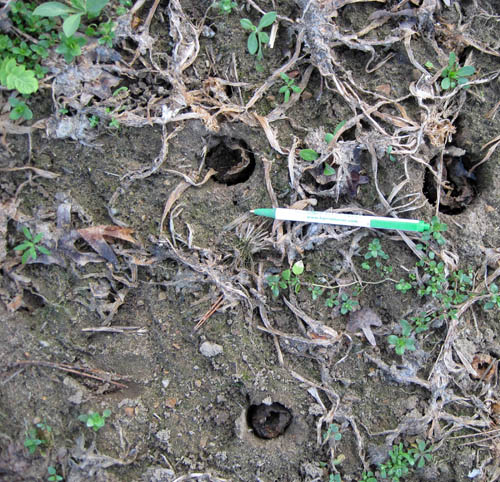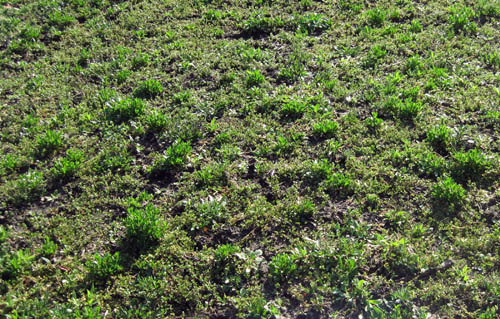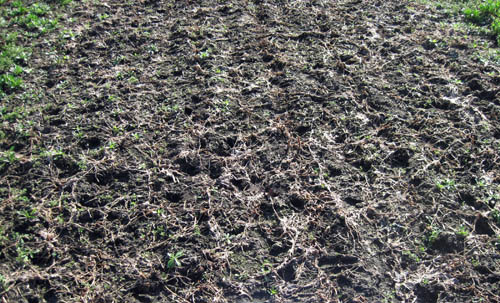Fall-planted brassica cover crop winter-kill and weed suppression
If you are looking for a cover crop to reduce compaction and suppress winter annual weeds, oilseed radish is worth considering.
Farmers are increasing their use of brassica cover crops, such as oilseed radish, mustards, and forage turnips, for fall planting. These cover crops get off to a fast start, providing rapid ground cover that protects the soil from erosion and helps suppress weeds. Some farmers consider oilseed radish to be a “bio-drill,” as its long taproots aerate the soil and help decrease compaction. The holes that are left behind once the roots rot do not interfere with cash crop planting. Both oilseed radishes and mustards can bloom when planted in the fall, and mustards in particular are popular with bees and other beneficial insects.

Holes left by oilseed radish
taproots in a field at the USDA-NRCS Rose Lake PMC, taken
March 2012. Photo
credit: V. Ackroyd.
Winter-kill
Brassica cover crops vary somewhat in their winter-hardiness, with mustards being more sensitive to cold temperatures than oilseed radishes and turnips. Temperatures below 28°F will generally kill brassica cover crops, though with adequate snow cover oilseed radishes have been known to overwinter in Michigan. This winter and spring have been unusually warm. In spite of the lack of continuous snow cover, some oilseed radish varieties have overwintered in a brassica cover crops variety trial at the USDA Natural Resources Conservation Service (NRCS) Rose Lake Plant Materials Center (PMC).

Oilseed radish over-wintered in a
field at the USDA-NRCS Rose Lake PMC, taken March
2012. Photo credit: V.
Ackroyd.
Weed suppression
Research is on-going into the weed suppression capacity of fall-planted brassica cover crops. Preliminary evidence suggests that oilseed radishes, in particular, are useful for winter annual weed control. Care should be taken to prevent brassica cover crops from going to seed, as they could potentially themselves become weeds.

Winter annual weed infestation in
a control plot at the USDA-NRCS Rose Lake PMC, taken
March 2012. Photo credit: V.
Ackroyd.

Weed-free plot that was planted
to oilseed radish in the fall of 2011 at the USDA-NRCS Rose
Lake PMC, taken
March 2012. Photo credit: V. Ackroyd.
The brassica cover crop variety trial conducted at the USDA-NRCS Rose Lake PMC was funded by Michigan State University Project GREEEN.



 Print
Print Email
Email


